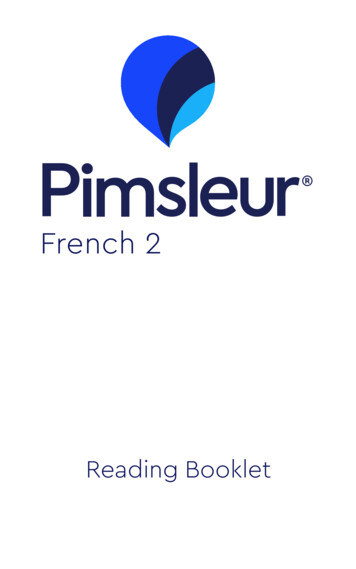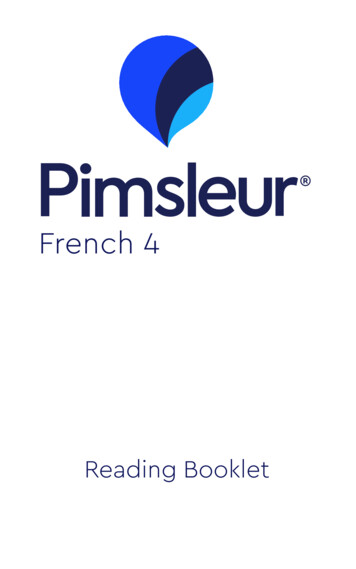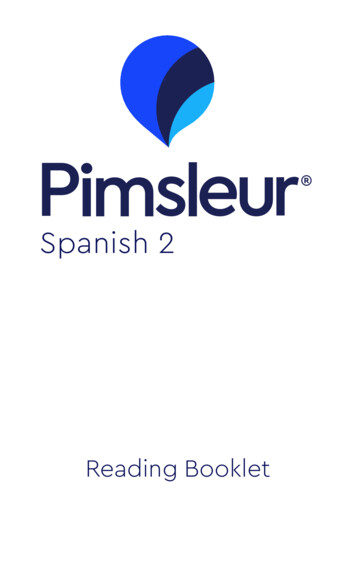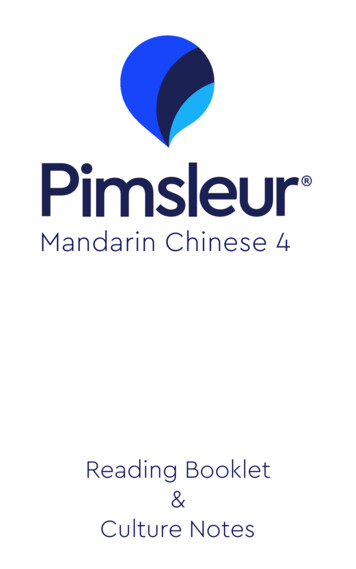
Transcription
French 2Reading Booklet
French 2Travelers should always check withtheir nation's State Department forcurrent advisories on local conditionsbefore traveling abroad.Booklet Design: Maia KennedyFourth Edition and ‰ Recorded Program 2019 Simon & Schuster, Inc. Reading Booklet 2019 Simon & Schuster, Inc.Pimsleur is an imprint of Simon & Schuster Audio,a division of Simon & Schuster, Inc. Mfg. in USA.All rights reserved.ii
French 2ACKNOWLEDGMENTSVoicesEnglish-Speaking Instructor . . . . . . . . . . Ray BrownFrench-Speaking Instructor . . . Dominique ClémentFemale French Speaker . . Marie-P. Grandin-GilletteMale French Speaker . . . . . . . . . . . . . . . Pierre HurelCourse WriterMarie-P. Grandin-GilletteEditorsElisabeth Weir Beverly D. HeinleReviewerKévin RocheronProducer & DirectorSarah H. McInnisRecording EngineerPeter S. TurpinSimon & Schuster Studios, Concord, MAiii
French 2Table of ContentsIntroduction. 1A Note on Use of Articles and Prepositions. 4Reading. 6Leçon un. 8Leçon deux. 10Leçon trois. 12Leçon quatre. 14Leçon cinq. 16Leçon six. 18Leçon sept. 20Leçon huit. 22Leçon neuf. 24Leçon dix. 26Leçon onze. 28Leçon douze. 30Leçon treize. 32Leçon quatorze. 34Leçon quinze. 36Leçon seize. 38Leçon dix-sept. 40Leçon dix-huit. 42Leçon dix-neuf. 44iv
French 2Leçon vingt. 46Leçon vingt-et-un. 48Leçon vingt-deux. 50Leçon vingt-trois. 52Leçon vingt-quatre. 54Leçon vingt-cinq. 56Leçon vingt-six. 58Leçon vingt-sept. 60Leçon vingt-huit. 62Leçon vingt-neuf. 64Leçon trente. 66v
French 2IntroductionWelcome to the Fourth Edition of Pimsleur’s FrenchLevel 2.French, the sixth most-spoken language in theworld, is a Romance language, which means itcomes down from the common Latin of the RomanEmpire. French has become an official language in 29francophone countries spanning five continents, andthere are numerous French-based creole languages,including Haitian Creole. French is a primary orsecondary language of numerous internationalorganizations including NATO, the European Union,the United Nations, the World Trade Organization,and many more, as well as having a distinguishedhistory as an international language of scientificstandards and literature.French has a deeply-ingrained relationship toEnglish dating from the Norman Conquest of England,and many English words have a French origin, includingthose related to food (such as restaurant, menu, café,salad, soup, beef, hors d’oeuvres, alcohol, and vinaigrette), as well as words connected to fashion (such aschic, silhouette, petite, faux), travel (depot, en route,souvenir, bon voyage) and various aspects of life, forexample: critique, entrepreneur or genre, toilet, coup,and cliché. “RSVP” is short for répondez s’il vous plaît,or, “please respond.”
French 2Languages are constantly evolving, reflectingchanges in their societies. French is no exception. Justas first names like Georges or Jacqueline are no longerfirst picks for French babies, the French you hearspoken in France today is not the same French youheard twenty years ago, and certainly no longer theFrench you previously learned in school, even thoughthe grammar is still largely the same.In this new edition we continue the general trend inFrance toward casual interaction. Although speakingpolitely and addressing people correctly is alwaysimportant, especially for beginning language learners,it is also useful to learn to interact more casually whiletraveling, working, or vacationing in France.French 2 continues to provide guidance aboutwhen to use the liaison (the linking of words, a featureof pronunciation aimed at making French sound morefluid) as it is less prevalent in conversation than itonce was. While some liaisons remain standard andmust be used (vous z-êtes, trois z-heures), others thatwere considered optional now tend to be droppedaltogether. For example, where once you might haveheard C’est t-ici (where the “t,” normally silent in est ispronounced as if it were part of the word ici), you’ll nowmore likely hear C’es(t) ici (where the “t” is silent, andthere is no linking between the two words). What waspronounced pas z-allé is now pa(s) allé, etc.2
French 2You’ll continue learning everyday contemporaryFrench as spoken in France. Of course there are regionalaccents, so if you travel outside of major cities to theseaside, or the countryside, or to the Alps, you mightneed to ask people to repeat themselves or speak moreslowly. This is a common occurrence in any language,and no one course can cover every possible regionalvariation; however, the French taught in this course willbe understood in every part of the country, and in mostplaces where French is spoken.Remember, speaking French clearly and naturallyis not always easy to do at an introductory level, andyou may want to repeat some lessons—as often asnecessary. The Pimsleur Method has a proven successrate and you will find that it is well worth the effort. Wehope you enjoy this latest edition.3
French 2A Note on the Use of Articles and PrepositionsBefore City, Region, and Country NamesIn Level 2 you will learn the names of new cities,regions/provinces and countries such as: Genève, Lyon, Montréal, Orléans, Québec,Rennes, Toulouse la Provence, le Québec la Belgique, le Canada, le Sénégal, la SuisseNote that, whereas the word for “a city” (une ville)is feminine, most cities have no gender and therefore,no article is used in front of them, as in Orléans, ce n’estpas très grand.Regions and countries, however, do have a genderin French. Just like all other French nouns, they areeither masculine or feminine. A quick way to determinethe gender of such nouns is to look at their ending: ifthe word for the country or region ends in an “e,” it’sfeminine; if not, it’s masculine. (There are a few exceptions.) You’ll say for example: Vous connaissez bien la France. J’aime beaucoup le Canada.You’ll need to keep this in mind when using prepositions such as à or de before city or country names. You’lluse the simple preposition with cities, for example: Ils habitent à Lyon. Il est à l’université de Rennes.4
French 2Things get somewhat trickier when you combine the preposition with the needed article withregions and countries. Remember that with allmasculine nouns: à combined with le becomes au à combined with les becomes aux de combined with le becomes du de combined with les becomes desWith this in mind, here is what you’ll say: Je vais au Sénégal. J’attends une lettre du Canada. J’aime bien conduire aux États-Unis.Before names of feminine countries or regions, theprepositions change as follows: à la will become en de la will become deFor example, you’ll say: L’essence est chère en France. Je voudrais aller en Angleterre. Je suis allée en Provence. Ils ne viennent pas d’Italie. Lui, il vient de Belgique.5
French 2ReadingReading is a critical part of learning and understanding a new language, but it may be for differentreasons than you think.If you’re like most people, you learned to speakyour native language well before you learned toread it: you learned reading later—and it’s a differenttype of language skill, which uses a different part ofyour brain.The symbols you see on a page—the alphabet—are a sort of shorthand for the sounds they represent.Inside those sounds is where meaning actually lives.Not only is reading a piece of a language puzzle,learning to read also gives you a chance to learn alanguage from a different direction than how you arelearning to speak in the audio lessons. This combination approach will help you build a solid bridgetoward fluency. In Level 2, you’ll continue to isolatesounds that run together in the spoken language thatyou couldn’t quite catch through listening alone, andyou’ll begin to notice patterns in words that will helpyou create a mental web of understanding. This is thenatural progression Dr. Pimsleur followed in all of hislanguage courses.6
French 2In Level 1, you acquired the sounds of your newlanguage, and learned about the impact that a symbol,accent, or stress has on pronunciation. In Level 2, you’llcontinue to practice sounding out words on sight andreading for meaning, at the same time expanding yourvocabulary. Translations are provided for each lesson,although we recommend that you look at the translations only after doing the lessons.As in Level 1, the Readings do not provide a list ofthe words or sentences taught in the audio lessons;we continue to take you to the source: sounds ofindividual letters and letter combinations, and you’llkeep learning how these sounds play out in wordsand sentences. Don’t be afraid to push yourself withyour pronunciation and accent. Be dramatic and havefun! The closer you can get to the native speaker’spronunciation, the more authentic your experiencewill be, and the more easily you’ll remember whatyou’ve learned.7
French 2Leçon un1.Bonjour à tous, c’est nous.2.On est finalement arrivés à Nice .3.et on aime beaucoup la région.4.Le petit studio qu’on a trouvé en ligne .5.est très joli, propre et clair .6.et pas loin du centre-ville.7.Il y a un café juste à côté.8.Hier on est allés .9.à un très bon concert .10.et ce soir on va au cinéma.11.Aujourd’hui il faisait très beau.12.Demain, on va louer une voiture .13.et partir une semaine à Monaco.14.Alors, à bientôt pour d’autres nouvelles.8
French 2Lesson One1.Hello all, it’s us.2.We finally arrived in Nice .3.and we like the area a lot.4.The small studio that we found online .5.is very pretty, clean and bright .6.and not far from the center of town.7.There is a café right next door.8.Yesterday we went .9.to a very good concert .10.and tonight we’re going to the movies.11.Today the weather was very nice.12.Tomorrow, we’re going to rent a car .13.and leave (go) to Monaco for a week.14.So, until soon for more news.9
French 2Leçon deux1.Je voudrais vous montrer .2.une nouvelle photo de famille.3.C’était chez mes parents il y a une semaine.4.Ici, en blanc, c’est ma grand-mère.5.Ici, à gauche, avec la barbe, .6.c’est son fils Michel, mon oncle.7.Et là, la jolie blonde, à droite, .8.c’est ma tante Hélène.9.Elle a cinquante-six ans, .10.et elle vient de se remarier.11.Son nouveau mari a dix ans de moins qu’elle.12.Ils sont charmants, non?13.Moi, je suis derrière, comme d’habitude, .14.entre mon père et ma mère.10
French 2Lesson Two1.I would like to show you .2.a new family photo.3.It was at my parents’ house a week ago.4.Here, in white, that’s my grandmother.5.Here, on the left, with the beard, .6.that’s her son Michel, my uncle.7.And there, the pretty blonde, on the right, .8.that’s my aunt Helene.9.She is fifty-six years old, .10.and she just got remarried.11.Her new husband is ten years younger thanshe is.12.They’re charming, no?13.Me, I’m in the back, as usual, .14.between my father and my mother.11
French 2Leçon trois1.Si vous ouvrez le réfrigérateur .2.dans ma cuisine, vous allez trouver .3.un gâteau d’anniversaire, .4.un bocal de cornichons, .5.un camembert de Normandie, .6.une demi-bouteille de vin blanc, .7.du beurre salé breton, et une laitue .8.qui n’est plus de la première fraîcheur.9.Il y a aussi une boite de sardines à lasauce tomate.10.Dans le congélateur il y a .11.deux ou trois bacs à glaçons, .12.des petits pois surgelés, .13.et de la glace à la pistache.14.Si on commandait une pizza?12
French 2Lesson Three1.If you open the refrigerator .2.in my kitchen, you’re going to find .3.a birthday cake, .4.a jar of pickles, .5.a camembert from Normandy, .6.a half-bottle of white wine, .7.salted Brittany butter, and a(head of) lettuce .8.which is no longer in its prime.9.There is also a can of sardines intomato sauce.10.In the freezer there are .11.two or three ice cube trays, .12.frozen peas, .13.and pistachio ice cream.14.What if we ordered a pizza?13
French 2Leçon quatre1.Le p
Welcome to the Fourth Edition of Pimsleur’s French Level 2. French, the sixth most-spoken language in the world, is a Romance language, which means it comes down from the common Latin of the Roman Empire. French has become an official language in 29 francophone countries spanning five continents, and there are numerous French-based creole languages, including Haitian Creole. French is a .











